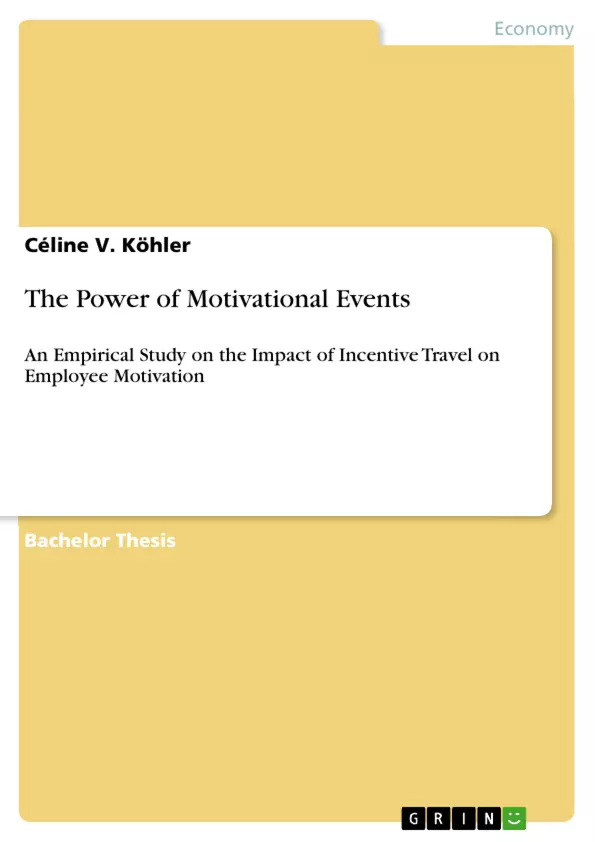Employee motivation has always been a highly researched topic. Employers spend large budgets on employee motivation because a motivated workforce is said to go hand-in-hand with corporate success. Incentive Travel is one form of a motivational tool and reward. More than a normal travel experience, it is considered to be an appropriate motivational event – from the journey itself, to the various activities and excursions included employees gain motivation. Different analyses have been made investigating the appraisal of Incentive Travel from the attendees’ perspective. However, little research has been made on the employers’ point of view and their appraisal of its motivational power.
Therefore, the aim of this dissertation is to investigate the motivational power of Incentive Travel on employee performance from the perspective of the employer. This is achieved by an in-depth evaluation of the theory behind Incentive Travel, as well as two motivational theories: ‘Expectancy Theory’ by Victor Vroom (1964) and ‘Equity Theory’ by John Adams (1963). To conjoin the theoretical part of this dissertation and to create a basis for primary research, the author has developed the ‘Incentive Travel – Motivation Model’. Research for the dissertation was conducted in form of an online survey of 117 CEO and managers who have personnel responsibility, that include Incentive Travel in the remuneration system of their company.
Inhaltsverzeichnis (Table of Contents)
- ACKNOWLEDGEMENTS
- ABSTRACT
- TABLE OF CONTENTS
- LIST OF APPENDICES
- LIST OF ABBREVIATIONS
- GENDER SENSITIVITY
- LIST OF FIGURES
- CHAPTER 1
- INTRODUCTION
- 1.1 BACKGROUND
- 1.2 AIM AND OBJECTIVES
- 1.3 STRUCTURE OF STUDY
- CHAPTER 2 - LITERATURE REVIEW
- 2.1 INCENTIVE TRAVEL
- 2.1.1 Incentive Travel as Motivator
- 2.1.2 Form and Content of Incentive Travel
- 2.2 EXPECTANCY THEORY
- 2.2.1 The Theory
- 2.2.2 Criticism and Modification
- 2.3 EQUITY THEORY
- 2.3.1 The Theory
- 2.3.2 Criticism and Modification
- 2.4 CONJUNCTION OF THE THEORIES
- CHAPTER 3 - RESEARCH METHODOLOGY
- 3.1 RESEARCH MODEL
- 3.2 RESEARCH PHILOSOPHY AND APPROACH
- 3.3 RESEARCH DESIGN
- 3.3.1 Methodological Choice
- 3.3.2 Research Strategy
- 3.4 RESEARCH ETHICS
- 3.5 DATA COLLECTION
- 3.5.1 Secondary Data
- 3.5.2 Questionnaires
- 3.5.3 Sampling
- 3.6 DATA ANALYSIS
- 3.7 LIMITATIONS
- CHAPTER 4 - ANALYSIS AND DISCUSSION OF FINDINGS
- 4.1 DEMOGRAPHIC INFORMATION
- 4.2 OVERALL ANALYSIS
- 4.2.1 Awarding of Incentive Travel
- 4.2.2 Characteristics of Incentive Travel Programs
- 4.2.3 Aftermath of Incentive Travel
- 4.2.4 Motivational Effects
- 4.2.5 Concluding Remarks for the Overall Analysis
- 4.3 SMALL vs. LARGE COMPANIES
- CHAPTER 5 - CONCLUSION AND RECOMMENDATIONS
- 5.1 CONCLUSION
- 5.2 RECOMMENDATIONS
- 5.2.1 Recommendations for Employers
- 5.2.2 Recommendations for Future Researchers
- REFERENCES
- LIST OF APPENDICES
Zielsetzung und Themenschwerpunkte (Objectives and Key Themes)
This dissertation aims to investigate the motivational power of Incentive Travel on employee performance from the employer's perspective. This research explores the theoretical framework behind Incentive Travel, encompassing 'Expectancy Theory' and 'Equity Theory'. The study utilizes an online survey of CEOs and managers responsible for personnel, who incorporate Incentive Travel into their companies' remuneration systems.
- The effectiveness of Incentive Travel as a motivational tool.
- The impact of Incentive Travel on employee performance.
- The application of Expectancy Theory and Equity Theory in the context of Incentive Travel.
- The influence of company size on the implementation and effectiveness of Incentive Travel programs.
- The importance of communication strategies and planning in maximizing the impact of Incentive Travel.
Zusammenfassung der Kapitel (Chapter Summaries)
- Chapter 1: Introduction Provides an overview of the research topic, including the background, aims, objectives, and structure of the study.
- Chapter 2: Literature Review Explores the theoretical framework behind Incentive Travel, including 'Expectancy Theory' and 'Equity Theory'.
- Chapter 3: Research Methodology Outlines the research model, philosophy, approach, design, ethics, data collection, and analysis methods.
- Chapter 4: Analysis and Discussion of Findings Presents the results of the survey, analyzing the demographic information, overall findings, and differences between small and large companies.
Schlüsselwörter (Keywords)
The main focus of this study lies on Incentive Travel, employee motivation, performance, Expectancy Theory, Equity Theory, and the impact of company size on the implementation and effectiveness of Incentive Travel programs. The research explores the practical implications of Incentive Travel, analyzing the communication strategies and planning required to maximize its motivational effects.
- Citar trabajo
- Céline V. Köhler (Autor), 2015, The Power of Motivational Events, Múnich, GRIN Verlag, https://www.grin.com/document/338395



